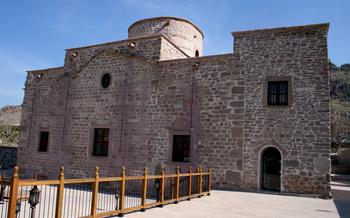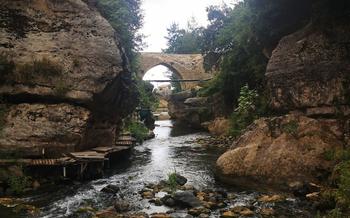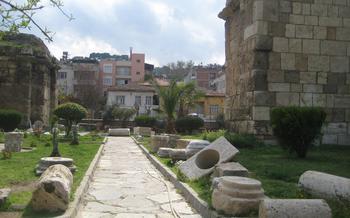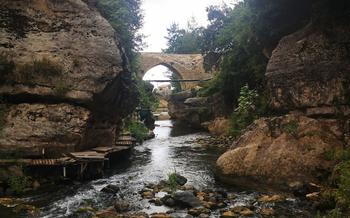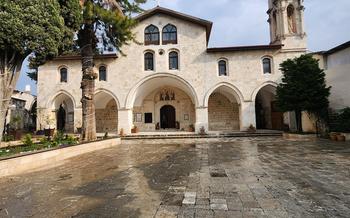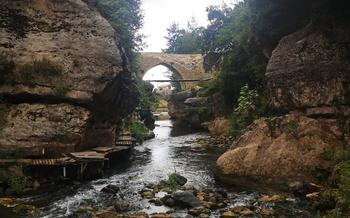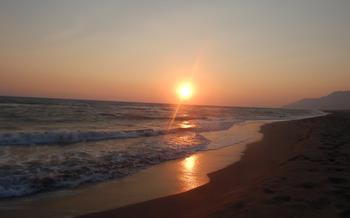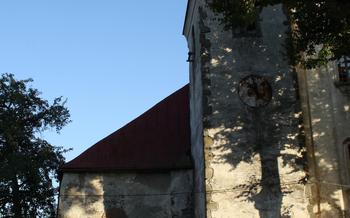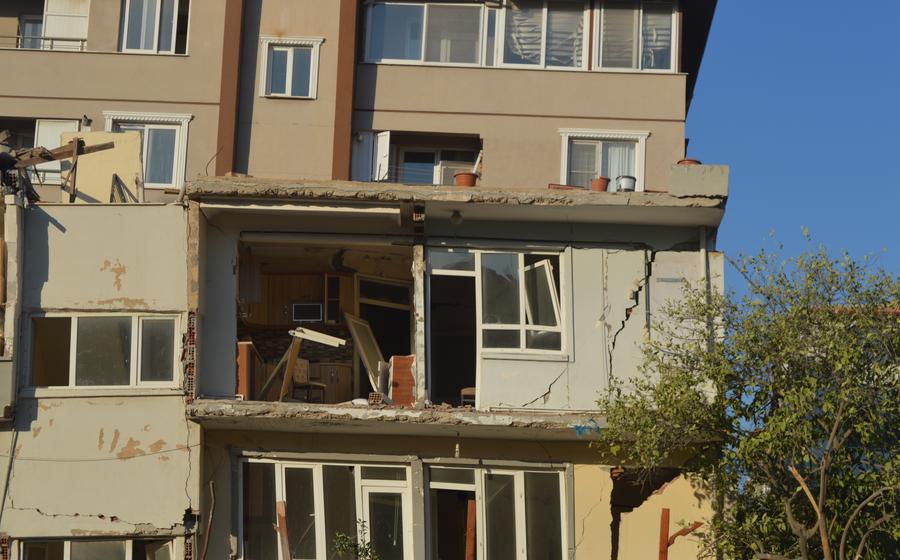
Kurtderesi Monastery
- Historical Background
- Location and Accessibility
- Architectural Marvels
- Religious Significance:
- Cultural Heritage
- Byzantine Art and Mosaics
- Historical Artifacts and Relics
- Natural Surroundings
- Local Cuisine and Hospitality
- Local Festivals and Events
- Nearby Attractions
- Practical Information
- Insider Tip:
Historical Background
The Kurtderesi Monastery stands as a testament to the rich history and cultural heritage of Turkey. Its origins can be traced back to the 4th century AD, making it one of the oldest and most well-preserved monasteries in the country. Constructed during the reign of the Byzantine Emperor Constantine the Great, the monastery played a pivotal role in the spread of Christianity throughout the Hatay region. Its strategic location along ancient trade routes facilitated the exchange of religious and cultural ideas between the Byzantine Empire and the neighboring regions. The monastery's unique architectural style, a blend of Roman and Byzantine influences, reflects the diverse cultural influences that shaped its history. Over the centuries, the Kurtderesi Monastery has stood as a symbol of faith, resilience, and the enduring legacy of Christianity in Turkey.
Location and Accessibility
The Kurtderesi Monastery is situated in the Belen district of the Hatay province in southern Turkey, approximately 40 kilometers northeast of the city of Antakya. The monastery is easily accessible by car, with well-maintained roads leading to its entrance. Visitors can also take a bus from Antakya to Belen and then transfer to a local minibus or taxi to reach the monastery.
For those traveling from afar, the nearest airport is Hatay Airport (HTY), which is located about 30 kilometers from the monastery. From the airport, visitors can take a taxi or rent a car to reach the monastery directly.
It is important to note that the roads leading to the monastery can be narrow and winding, especially in the mountainous sections. Visitors should exercise caution while driving and be prepared for potential traffic delays, particularly during peak tourist season. Additionally, it is recommended to have a basic understanding of Turkish or to travel with a guide who can assist with communication and navigation.
Architectural Marvels
The Kurtderesi Monastery is a testament to the architectural prowess of its builders. Its stunning architecture showcases a harmonious blend of Roman and Byzantine influences, creating a masterpiece that has stood the test of time. The intricate carvings that adorn the exterior walls depict scenes from the Bible, while the colorful mosaics that grace the interior depict religious figures and saints. The towering columns that support the structure add a sense of grandeur and majesty. The monastery's unique architectural style has earned it recognition as one of the most significant examples of early Christian architecture in Turkey.
Recent restoration efforts have been undertaken to preserve the monastery's integrity and ensure its continued existence for future generations. These efforts have focused on repairing and restoring the intricate carvings and mosaics, as well as stabilizing the structure to prevent further deterioration. The restoration work has been carried out with the utmost care and precision, ensuring that the monastery's original beauty and historical significance are maintained.
Religious Significance:
The Kurtderesi Monastery holds immense religious significance as a center of Christianity in the Hatay province. Founded in the 4th century AD, the monastery played a pivotal role in spreading Christianity throughout the region and beyond. It served as a sanctuary for early Christians, providing them with a safe haven to practice their faith during times of persecution. Throughout history, notable religious figures have visited and resided at the monastery, leaving behind a legacy of spiritual teachings and practices.
The monastery's impressive architecture reflects its religious importance. The intricately carved stonework, colorful mosaics, and towering columns create a sacred space that inspires awe and devotion. The monastery's layout, with its central courtyard and surrounding chapels, facilitates communal prayer and contemplation. Visitors can still witness the remnants of ancient rituals and traditions, such as the baptismal font and the altar, which evoke a sense of the monastery's enduring religious significance.
To this day, the Kurtderesi Monastery remains a place of pilgrimage and worship for Christians from around the world. Pilgrims come to seek spiritual guidance, pray for miracles, and experience the tranquility of this holy site. The monastery's religious significance continues to attract visitors who seek a deeper connection with their faith and a glimpse into the rich history of Christianity in Turkey.
Cultural Heritage
The Kurtderesi Monastery stands as a testament to the rich cultural heritage of the Hatay region. Throughout its long history, the monastery has served as a sanctuary for scholars, artists, and musicians, offering them a refuge during times of conflict and persecution. Within its walls, a vibrant intellectual and artistic community flourished, contributing to the development of the region's unique cultural identity.
The monastery's library, once renowned for its vast collection of manuscripts and texts, played a crucial role in preserving and transmitting knowledge across generations. Here, scholars engaged in the study of theology, philosophy, and the arts, fostering a spirit of intellectual inquiry and debate. The monastery's scriptorium was a hub of literary activity, where monks meticulously copied and illuminated manuscripts, ensuring the survival of ancient texts and ideas.
Beyond its religious significance, the monastery also served as a center for the arts. Talented artists and musicians found patronage within its walls, creating exquisite works that adorned the monastery's interiors and enriched its spiritual atmosphere. The monastery's workshops produced intricate mosaics, delicate frescoes, and finely carved sculptures, each a testament to the skill and devotion of the artists who created them.
The cultural legacy of the Kurtderesi Monastery extends far beyond its physical walls. Its role in preserving and promoting knowledge, art, and music has left an indelible mark on the region's cultural landscape. To this day, the monastery continues to inspire and captivate visitors with its rich history and enduring cultural significance.
Ongoing cultural events and initiatives at the monastery seek to preserve and promote its heritage. Regular concerts, exhibitions, and workshops showcase the work of local artists and musicians, while educational programs introduce visitors to the monastery's history and cultural contributions. These initiatives ensure that the Kurtderesi Monastery remains a vibrant center of cultural exchange and learning, carrying its legacy into the future.
Byzantine Art and Mosaics
The Kurtderesi Monastery is renowned for its exquisite Byzantine art and mosaics, which adorn the interior walls and ceilings with vibrant colors and intricate designs. These stunning artworks were created using a technique called opus sectile, which involves cutting colored glass or stone into small pieces and arranging them to form intricate patterns and images. The mosaics depict a variety of religious scenes, saints, and biblical narratives, providing a glimpse into the theological and artistic traditions of the Byzantine Empire.
One of the most striking mosaics is the depiction of the Virgin Mary with the Christ Child in her arms, surrounded by angels and saints. The Virgin's face is rendered with remarkable detail and emotion, capturing her serene and compassionate expression. Another notable mosaic is the "Last Supper," which portrays Jesus and his disciples gathered around a table, sharing their final meal together before his crucifixion. The intricate details of the mosaic, such as the expressions on the disciples' faces and the arrangement of the food on the table, bring the scene to life.
These Byzantine mosaics are a testament to the skill and artistry of the craftsmen who created them. They have survived for centuries, despite the passage of time and the ravages of war, and continue to inspire and awe visitors to the Kurtderesi Monastery.
Historical Artifacts and Relics
The Kurtderesi Monastery has yielded a treasure trove of historical artifacts and relics that provide invaluable insights into its past. Archaeological excavations have uncovered ancient manuscripts, religious objects, and everyday items that shed light on the daily lives of the monks and the monastery's role in the region. Among the most significant discoveries are beautifully illuminated manuscripts, intricately carved stone carvings, and well-preserved pottery fragments. These artifacts provide tangible evidence of the monastery's rich history and artistic traditions. Ongoing archaeological projects continue to uncover new treasures, adding to our understanding of this remarkable site. The preservation and protection of these artifacts are of utmost importance for future generations, ensuring that the legacy of the Kurtderesi Monastery remains alive.
Natural Surroundings
The Kurtderesi Monastery is nestled amidst a breathtaking natural landscape, where rolling hills, lush forests, and a serene river converge to create an atmosphere of tranquility and serenity. The monastery's secluded location, surrounded by nature's beauty, contributed to its spiritual aura and sense of peace. Visitors can immerse themselves in the tranquility of the surroundings, taking leisurely walks along the riverbanks, exploring the nearby forests, or simply relaxing on the monastery grounds, enjoying the fresh air and the sounds of nature.
Several hiking trails wind through the picturesque landscape, inviting visitors to explore the region's natural wonders. Hikers can choose from various trails, ranging from easy walks suitable for families to more challenging routes that lead to hidden waterfalls, panoramic viewpoints, and ancient ruins. Along the way, they can encounter a diverse array of flora and fauna, including colorful wildflowers, towering trees, and various bird species.
The river that flows nearby adds to the charm of the monastery's surroundings. Visitors can enjoy a refreshing dip in the cool waters or simply relax on the riverbank, listening to the soothing sounds of the flowing water. The river is also a popular spot for fishing and birdwatching, providing opportunities for visitors to connect with nature and enjoy the tranquility of the environment.
The natural beauty of the Kurtderesi Monastery's surroundings is a reminder of the region's rich biodiversity and the importance of preserving its natural heritage. Visitors are encouraged to respect and protect the environment, ensuring that future generations can continue to enjoy the monastery's serene setting and the natural wonders that surround it.
Local Cuisine and Hospitality
The Hatay province is renowned for its rich and diverse cuisine, a reflection of its unique cultural heritage and geographical location. Visitors to the Kurtderesi Monastery can indulge in a culinary journey that tantalizes their taste buds and introduces them to the flavors of the region.
From traditional kebabs and meze platters to fresh seafood and delectable desserts, Hatay's cuisine offers a feast for the senses. Savor the succulent flavors of grilled meats, marinated in aromatic spices and cooked to perfection. Sample an array of meze dishes, such as hummus, baba ghanoush, and stuffed vine leaves, each bursting with unique flavors and textures. Indulge in the freshness of seafood caught from the nearby Mediterranean Sea, prepared with simple yet delicious techniques that highlight the natural flavors.
Beyond the culinary delights, the Hatay people are known for their warm hospitality and welcoming nature. Visitors to the region are often greeted with open arms and a genuine desire to share the local culture and traditions. Support local businesses by dining at family-run restaurants or cafes, where you can experience authentic Hatay cuisine and engage with the friendly locals.
Throughout the year, Hatay hosts a variety of food festivals and culinary events that celebrate the region's rich gastronomic heritage. These events provide an opportunity to sample a wide range of local dishes, witness live cooking demonstrations, and learn about the culinary traditions of Hatay.
Local Festivals and Events
Hatay is a region renowned for its vibrant culture and traditions, which are celebrated through various local festivals and events throughout the year. These events offer visitors a unique opportunity to immerse themselves in the region's rich heritage and experience its diverse offerings.
One of the most significant religious holidays in Hatay is the Feast of Saint Simeon, which takes place on February 3rd. This festival commemorates the life of Saint Simeon the Stylite, a renowned ascetic who lived on a pillar near the city of Antioch. During the festival, pilgrims from across the region gather at the Saint Simeon Monastery to pay homage to the saint and participate in special religious ceremonies.
Hatay is also home to several music festivals that showcase the region's rich musical traditions. The Hatay International Music Festival, held annually in September, features performances by renowned musicians from Turkey and around the world. The festival offers a diverse range of genres, from traditional Turkish music to classical and contemporary sounds.
For those interested in experiencing the region's culinary delights, the Hatay Gastronomy Festival is a must-attend event. Held annually in October, the festival brings together local chefs and food enthusiasts to celebrate the diverse culinary traditions of Hatay. Visitors can indulge in a variety of traditional dishes, such as kebabs, meze platters, and fresh seafood, while enjoying live music and cultural performances.
To make the most of your visit to Hatay, it is recommended to plan your trip around these local festivals and events. The best time to visit the region is during the spring or fall, when the weather is pleasant and the festivals are in full swing.
Nearby Attractions
In addition to the Kurtderesi Monastery, the Hatay province offers a wealth of other attractions and landmarks that visitors can explore. History buffs can delve into the ancient ruins of the Zeugma Mosaic Museum, home to some of the most stunning Roman mosaics in the world. Nature lovers can embark on a scenic hike through the lush forests of the Samandag National Park, where they can spot rare birds and admire cascading waterfalls. And those seeking a cultural experience can visit the Hatay Archaeology Museum to learn about the region's rich history and diverse heritage.
For a comprehensive overview of the region's offerings, consider creating a suggested itinerary that includes multiple attractions. For example, you could start your day with a visit to the Kurtderesi Monastery, followed by a traditional Turkish lunch in the nearby town of Antakya. In the afternoon, explore the ancient ruins of Zeugma and admire its exquisite mosaics. To end the day, relax and unwind in the natural beauty of Samandag National Park, taking in the breathtaking views of the Mediterranean Sea.
Whether you have limited time or are looking to explore the surrounding area, Hatay offers a variety of attractions and experiences that will appeal to every traveler. So, be sure to allocate ample time to discover the many hidden gems that this vibrant province has to offer.
Practical Information
Before embarking on your journey to the Kurtderesi Monastery, it is essential to be well-informed about practical matters to ensure a smooth and enjoyable visit. The monastery typically opens its doors to visitors from 9:00 AM to 5:00 PM daily, allowing ample time to explore its architectural wonders and serene atmosphere. Admission fees are minimal, symbolizing the monastery's commitment to welcoming all who seek spiritual and historical enrichment.
Guided tours are available for those who wish to delve deeper into the monastery's rich history and significance. Led by knowledgeable guides, these tours provide insightful commentary and anecdotes, bringing the monastery's past to life. Visitors can inquire about guided tour options at the monastery's entrance or through local tour operators.
While exploring the monastery's grounds, visitors can take advantage of the well-maintained restrooms and ample parking facilities. A small gift shop offers a selection of souvenirs and religious artifacts, allowing visitors to take a piece of the monastery's charm back home.
To fully appreciate the monastery's tranquility and avoid the midday heat, it is advisable to plan your visit during the early morning or late afternoon hours. Comfortable clothing and sturdy footwear are recommended, as the monastery's uneven terrain and historical structures require careful navigation.
Insider Tip:
For an unforgettable experience, consider visiting the Kurtderesi Monastery during the annual Hatay Culture and Arts Festival, usually held in the spring. This vibrant festival showcases the region's rich cultural heritage through traditional music, dance, food, and artesanía. Immerse yourself in the lively atmosphere, enjoy performances by local artists, and savor the delicious local cuisine. It's a fantastic opportunity to witness the vibrant cultural tapestry of Hatay and create lasting memories.
